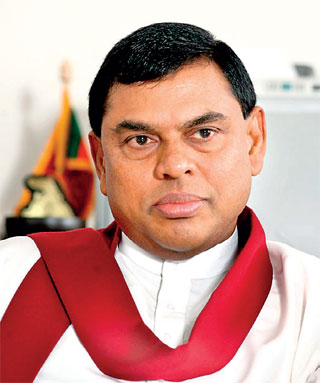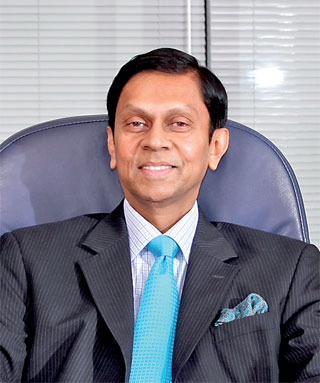Thursday Dec 18, 2025
Thursday Dec 18, 2025
Friday, 11 March 2022 02:57 - - {{hitsCtrl.values.hits}}
By Sunil Lasantha Perera
 |
| Finance Minister Basil Rajapaksa |
 |
| Central Bank Governor Nivard Cabraal
|
Chapter 1: Strategies to narrow SL’s recurrent budget deficit
1.1 The target should be for the recurrent expenditure, to be financed by total Govt. revenue.
90% of Govt. revenue comes from taxes (income/corporate tax, VAT, excise/stamp duty, import duty)
1.2 Strategies to increase Govt. revenue.
i.Re-introduce withholding tax (WHT). It is a method of collection and not a tax.
ii.Tax collection is more important than revenue (see notes in chapter 3 for details)
iii.Do not reduce taxes anymore. Instead increase the tax relief thresholds.
iv.Tax harmful food like sugar (diabetes/obese), salt (high blood pressure), palm/coconut oil (saturated fat forming bad LDL cholesterol). Tax it like for cigarettes, alcohol.
v.Increase price of petrol, to recover costs. No need to subsidise petrol, as it is used in cars, by affordable high/mid income groups. Have a cross subsidy to cover low current tariff of diesel/kerosene. Lower use of petrol will prevent emission of harmful fumes to environment.
1.3 Strategies to reduce recurrent expenditure.
i.Stop or minimise additional staff hires; transfers, promotions are alright. “On-the job” train new graduates (60,000) for senior positions; staff hires in revenue generating departments (e.g., Inland revenue – IRD, passport office, customs), could continue as it is.
1.4 Introduce job banks and labour market at district level.
a) In 1950s, SL had an “Employment Bureau”, in Colombo 1, opposite the CTO office
b) Labour markets are successful in Afghanistan, Albania. It is a place where employers and unemployed labour meet. It is ideal for skilled/unskilled labour. Job banks are in the SLPP manifesto. It will reduce unemployment. Do a pilot project in 2 districts; then roll it out.
1.5 Get Govt. departments to submit “Detailed Annual Budgets”, like in municipalities/urban councils. Each budget line item should be detailed in an annex, with quantity, rate per unit, value (Rs.). These details will enable managers to cut waste/excess expenditure, before finalising the budget. It will ease the budget approval process.
Chapter 2: Strategies to increase the inflow of foreign currency to Sri Lanka in the short-term
Target: Increase additional inflow of $ 10 billion, in short-term
2.1 Market penetration
There are local products/services that have a high demand locally and overseas. SL should increase production with same quality by working another work shift, so that imports could be substituted, and exports increased. Once the local production increase, the relevant import could be banned.
The sectors are as follows:
i.Pharmaceutical drugs
ii.Tyres, batteries
iii.Local assembly of cars, motorcycles, three-wheelers
iv.Boats, yachts, ship building. Get EDB to showcase
v.Seaports, airports to be used as hubs (like in Dubai, Singapore, Mumbai)
vi.Export organic farm products at higher prices
vii.Shoes (Bata, DSI)
viii.Sri Lankan airlines could bring in and connect transit passengers (e.g., Lon- Col – Male)
ix.Go back to 2018, get 2.5 million tourists and target $ 5 billion. Tourism infrastructure and resources are already available.
2.2 Sale of condo apartments
There are about 5,000 apartments already in stock for sale. Showcase it through EDB to the foreign market and diaspora. This could bring in $ 2 billion in the short-term.
2.3 Customer
Four “P’s” (Product, Price, Place, Promotion) in Marketing is incomplete without the “Customer” in the equation. It should be “Customer + 4P’s”. For market penetration, “Customer + 4P’s” is the key.
Market penetration is the theme of this chapter.
See notes in chapter 4, for details.
Chapter 3: Notes to Chapter 1 – Strategies to narrow SL recurrent budget deficit
3.1 Increase tax collection
While 90% of Govt. revenue comes from taxes (income tax, VAT, excise/stamp duty), income tax is 20% of it.
i.Inland Revenue Department should interview taxpayers, owing more than Rs. 1 million; agree on a timeframe, waive penalties and avoid lengthy, time-consuming enforcements, legal action. Work with the taxpayers not against them, win their trust and confidence.
Apply above procedure for dishonoured cheques accounting to more than Rs. 2 billion.
ii.IRD should close or make the following tax files inactive in RAMIS
a)Those who earn less than Rs. 3 million per year
b)Those who pay “APIT” through employer salary deduction and have no other income
c)Those with exempt income (e.g., USD interest on USD fixed deposits)
The above will ease tax admin.
d)Reward taxpayers more than Rs. 1 million with a plastic “Priority Card” (Platinum, Gold, Silver), allowing them priority in Govt. departments, IRD, hospital, police.
e)Erect sign boards titled “Your tax rupees at work”, in public service places like hospitals, schools, universities, medical clinics, parks, irrigation tanks, hydro-power dams, roads, highways, bridges, playgrounds, sports stadiums, airports, postal envelopes, railway stations, tunnels, flyovers, bypasses, vaccine centres, low-income houses/condos, NWSDB water supply, LECO/CEB offices, markets, bus terminals, orphanages, zoo/gardens.
This is done in USA. It gives ownership, purpose to taxpayers.
iii.Use 80/20 rule. Concentrate on the 20% large taxpayers who bring in 80% of revenue.
iv.Reduce the number of schedules in the annual “Return of Income”. Make it simple.
3.2 Capital Expenditure (Capex)
Capex could be by joint ventures, BOT, borrowings for the time-being.
Contd on page 17
(There are no patents or copyrights to my paper. Feel free to copy, particularly by research students. If any part of this paper is useful, then it will be my answer to the question “What can I do for my country?” My 50-year worldwide work experience was used to write this paper.)
(The writer is a Chartered Accountant, MBA (Sri Lanka). He worked in USA for 25 years on USAID, World Bank, ADB and inter-American bank projects. He was based in Washington DC for 7 years, Russia 5 years, Afghanistan 10 years. He worked in 15 countries worldwide on donor-funded development projects.)
Chapter 4: Notes to Chapter 2 – Strategies to increase the inflow of foreign currency to Sri Lanka
4.1 Market penetration is not restricted by COVID-19. Market diversification takes time and investment.
4.2 Substituting imports with local products is equivalent to exports.
4.3 There is a high demand for SPC local drugs, which is in short supply. Work another shift.
4.4 Impact of market penetration brings immediate relief to SL. The capacity and resources are locally available. Capital investment is minimal.
4.5 Private sector is the “Engine of Growth”, for this purpose.
4.6 Govt. budget has no connection with chapter 2 – increase foreign currency inflow to Sri Lanka.
4.7 Once the dollars start coming in, the exchange rate will appreciate. The target should be 1 USD = Rs. 100. (In 2005, it was Rs. 96 to 1 USD). Go backwards.
4.8 Tourism is vulnerable because of the human factor, viz. COVID-19, terrorism, emergencies. Do not depend too much on tourism. Market penetration of local products is the answer.
4.9 If the exchange rate appreciates to say Rs. 100 to 1 USD, then the cost of living will go down. Current salaries will be like double. Let us think about it, after the positive event.
4.10 It is sad to note that in Sri Lanka, some hotels, restaurants, mall shops, supermarkets, condos, cater only to foreigners and local elite. Most of them are now bankrupt. Treat all people as “customers”, for market penetration. In USA, customer is considered a “King”, in Japan, customer is a “God”. In Sri Lanka customer is considered a “nuisance” most of the time. It is poor at its best. Change the attitude.
4.11 IMF borrowing is not recommended because of their destructive pre-conditions. It is recommended to speak to President Xi of China, and ask for a loan of $ 10 billion, to service debts in 2022, and have a minimal reserve of $ 7 billion. This discussion may have to be done at our President or Prime Minister level.
Chapter 5: Game-changers in the long-term and “Next Steps”
5.1 On-going mega projects
Benefits of the following on-going mega projects will come in the long-term of 5-20 years.
-Colombo Port City (2030-40)
-Petroleum and gas exploration in Mannar basin, estimated at $ 260 billion (5-10 years)
-BOI investments (5-10 years)
We cannot wait for the long-term, because of the current financial crisis. We need a solution now and in the short-term of 1-2 years.
Strategies for a short-term solution is given in this paper.
5.2 Next steps
Next step is to prepare an “Action Plan” with the following:
-What is to be done
-Who will do it
-Time frame (short-term)
-Estimated results and money values
A brief action plan will be prepared shortly.
5.3 The key to immediate solution is “market penetration”, by working another shift in a production economy, while maintaining the same quality. Active participation of the private sector is essential for this purpose to increase output.
EDB has to showcase the products to the foreign market, like for tea and tourism.
Dedication
All my efforts in producing this non-political paper, is dedicated to the free education, I received in Sri Lanka.